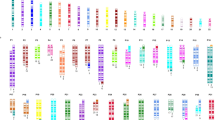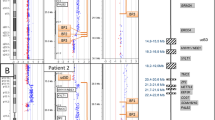Abstract
Overgrowth syndromes are a heterogeneous group of conditions including endocrine hormone disorders, several genetic syndromes and other disorders with unknown etiopathogenesis. Among genetic causes, chromosomal deletions and duplications such as dup(4)(p16.3), dup(15)(q26qter), del(9)(q22.32q22.33), del(22)(q13) and del(5)(q35) have been identified in patients with overgrowth. Most of them, however, remain undetectable using banding karyotype analysis. In this study, we report on the analysis using a 1-Mb resolution array-based comparative genomic hybridization (CGH) of 93 patients with either a recognizable overgrowth condition (ie, Sotos syndrome or Weaver syndrome) or an unclassified overgrowth syndrome. Five clinically relevant imbalances (three duplications and two deletions) were identified and the pathogenicity of two additional anomalies (one duplication and one deletion) is discussed. Altered segments ranged in size from 0.32 to 18.2 Mb, and no recurrent abnormality was identified. These results show that array-CGH provides a high diagnostic yield in patients with overgrowth syndromes and point to novel chromosomal regions associated with these conditions. Although chromosomal deletions are usually associated with growth retardation, we found that the majority of the imbalances detected in our patients are duplications. Besides their importance for diagnosis and genetic counseling, our results may allow to delineate new contiguous gene syndromes associated with overgrowth, pointing to new genes, the deregulation of which may be responsible for growth defect.
Similar content being viewed by others
Log in or create a free account to read this content
Gain free access to this article, as well as selected content from this journal and more on nature.com
or
References
Partington MW, Fagan K, Soubjaki V, Turner G : Translocations involving 4p16.3 in three families: deletion causing the Pitt-Rogers-Danks syndrome and duplication resulting in a new overgrowth syndrome. J Med Genet 1997; 34: 719–728.
Faivre L, Gosset P, Cormier-Daire V et al: Overgrowth and trisomy 15q26.1-qter including the IGF1 receptor gene: report of two families and review of the literature. Eur J Hum Genet 2002; 10: 699–706.
Tatton-Brown K, Pilz DT, Orstavik KH et al: 15q overgrowth syndrome: a newly recognized phenotype associated with overgrowth, learning difficulties, characteristic facial appearance, renal anomalies and increased dosage of distal chromosome 15q. Am J Med Genet A 2009; 149A: 147–154.
Kurotaki N, Imaizumi K, Harada N et al: Haploinsufficiency of NSD1 causes Sotos syndrome. Nat Genet 2002; 30: 365–366.
Redon R, Baujat G, Sanlaville D et al: Interstitial 9q22.3 microdeletion: clinical and molecular characterisation of a newly recognised overgrowth syndrome. Eur J Hum Genet 2006; 14: 759–767.
Phelan MC, Rogers RC, Saul RA et al: 22q13 deletion syndrome. Am J Med Genet 2001; 101: 91–99.
Cole TR, Hughes HE : Sotos syndrome: a study of the diagnostic criteria and natural history. J Med Genet 1994; 31: 20–32.
Rio M, Clech L, Amiel J et al: Spectrum of NSD1 mutations in Sotos and Weaver syndromes. J Med Genet 2003; 40: 436–440.
Baujat G, Rio M, Rossignol S et al: Clinical and molecular overlap in overgrowth syndromes. Am J Med Genet C Semin Med Genet 2005; 137C: 4–11.
Weksberg R, Smith AC, Squire J, Sadowski P : Beckwith-Wiedemann syndrome demonstrates a role for epigenetic control of normal development. Hum Mol Genet 2003; 12 (Spec No 1): R61–R68.
Baujat G, Rio M, Rossignol S et al: Paradoxical NSD1 mutations in Beckwith-Wiedemann syndrome and 11p15 anomalies in Sotos syndrome. Am J Hum Genet 2004; 74: 715–720.
Lapunzina P, Gairi A, Delicado A et al: Macrocephaly-cutis marmorata telangiectatica congenita: report of six new patients and a review. Am J Med Genet A 2004; 130A: 45–51.
Williams DK, Carlton DR, Green SH, Pearman K, Cole TR : Marshall-Smith syndrome: the expanding phenotype. J Med Genet 1997; 34: 842–845.
Neri G, Gurrieri F, Zanni G, Lin A : Clinical and molecular aspects of the Simpson-Golabi-Behmel syndrome. Am J Med Genet 1998; 79: 279–283.
Romana SP, Cherif D, Le Coniat M, Derre J, Flexor MA, Berger R : In situ hybridization to interphase nuclei in acute leukemia. Genes Chromosomes Cancer 1993; 8: 98–103.
Hannes FD, Sharp AJ, Mefford HC et al: Recurrent reciprocal deletions and duplications of 16p13.11: the deletion is a risk factor for MR/MCA while the duplication may be a rare benign variant. J Med Genet 2009; 46: 223–232.
Van Esch H, Hollanders K, Badisco L et al: Deletion of VCX-A due to NAHR plays a major role in the occurrence of mental retardation in patients with X-linked ichthyosis. Hum Mol Genet 2005; 14: 1795–1803.
Van Esch H, Bauters M, Ignatius J et al: Duplication of the MECP2 region is a frequent cause of severe mental retardation and progressive neurological symptoms in males. Am J Hum Genet 2005; 77: 442–453.
del Gaudio D, Fang P, Scaglia F et al: Increased MECP2 gene copy number as the result of genomic duplication in neurodevelopmentally delayed males. Genet Med 2006; 8: 784–792.
Lugtenberg D, Kleefstra T, Oudakker AR et al: Structural variation in Xq28: MECP2 duplications in 1% of patients with unexplained XLMR and in 2% of male patients with severe encephalopathy. Eur J Hum Genet 2009; 17: 444–453.
de la Cova C, Abril M, Bellosta P, Gallant P, Johnston LA : Drosophila myc regulates organ size by inducing cell competition. Cell 2004; 117: 107–116.
Moreno E, Basler K : dMyc transforms cells into super-competitors. Cell 2004; 117: 117–129.
Marcelis CL, Hol FA, Graham GE et al: Genotype-phenotype correlations in MYCN-related Feingold syndrome. Hum Mutat 2008; 29: 1125–1132.
Martinou I, Fernandez PA, Missotten M et al: Viral proteins E1B19K and p35 protect sympathetic neurons from cell death induced by NGF deprivation. J Cell Biol 1995; 128: 201–208.
Eng C : PTEN: one gene, many syndromes. Hum Mutat 2003; 22: 183–198.
Blumenthal GM, Dennis PA : PTEN hamartoma tumor syndromes. Eur J Hum Genet 2008; 16: 1289–1300.
Butler MG, Dasouki MJ, Zhou XP et al: Subset of individuals with autism spectrum disorders and extreme macrocephaly associated with germline PTEN tumour suppressor gene mutations. J Med Genet 2005; 42: 318–321.
Orrico A, Galli L, Buoni S, Orsi A, Vonella G, Sorrentino V : Novel PTEN mutations in neurodevelopmental disorders and macrocephaly. Clin Genet 2009; 75: 195–198.
Acknowledgements
We express our gratitude to the patients and their families. This study was supported by the Centre National de la Recherche Scientifique, the GIS-Maladies Rares and the Agence de Biomédecine.
Author information
Authors and Affiliations
Corresponding author
Rights and permissions
About this article
Cite this article
Malan, V., Chevallier, S., Soler, G. et al. Array-based comparative genomic hybridization identifies a high frequency of copy number variations in patients with syndromic overgrowth. Eur J Hum Genet 18, 227–232 (2010). https://doi.org/10.1038/ejhg.2009.162
Received:
Revised:
Accepted:
Published:
Issue date:
DOI: https://doi.org/10.1038/ejhg.2009.162
Keywords
This article is cited by
-
The emerging role of genomics in the diagnosis and workup of congenital urinary tract defects: a novel deletion syndrome on chromosome 3q13.31-22.1
Pediatric Nephrology (2014)
-
The test characteristics of head circumference measurements for pathology associated with head enlargement: a retrospective cohort study
BMC Pediatrics (2012)
-
Syndrome mit dem Leitsymptom Großwuchs
Medizinische Genetik (2011)



